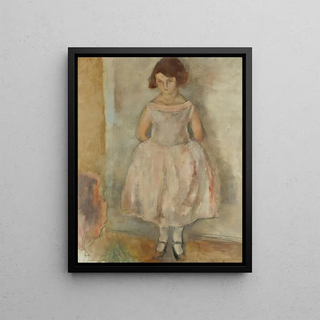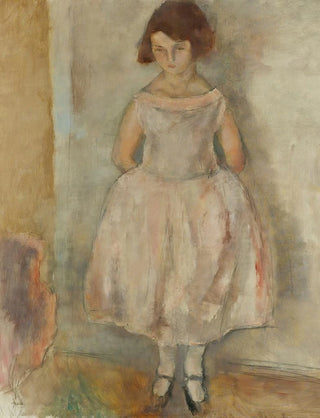Art print | Portrait of a Young Girl - Jules Pascin


View from behind

Frame (optional)
Portrait of a young girl - Jules Pascin – Captivating introduction
The "Portrait of a young girl" by Jules Pascin is a work that evokes rare delicacy and emotional depth. This painting, created in the early 20th century, captures with remarkable finesse the essence of youth and innocence. The female figure, both dreamy and introspective, seems to rise beyond the canvas, inviting the viewer to explore her inner world. Through this work, Pascin offers us a poetic vision of youth, tinged with subtle melancholy. Every brushstroke tells a story, an emotion, a thought, making this portrait a true window into the human soul.
Style and uniqueness of the work
Pascin's style is characterized by a harmonious combination of flowing lines and soft colors, which give his works an airy lightness. In the "Portrait of a young girl," the pastel palette chosen by the artist emphasizes the softness of the young woman's skin, while the delicately placed shadows add a dimension of depth and realism. The composition is both simple and complex, where each element contributes to the overall balance of the work. The way Pascin plays with light and shapes creates an atmosphere that is both intimate and universal, allowing the viewer to identify with the depicted figure. This portrait is not just a representation, but an invitation to feel and contemplate.
The artist and his influence
Jules Pascin, born in Bulgaria and raised in an artistic environment in Paris, established himself as an emblematic figure of modern art. Influenced by the currents of his time, such as Fauvism and Expressionism, Pascin developed a unique style that is his own. His work often explores themes related to urban life, women, and the human condition, revealing a keen sensitivity to the fleeting beauty of existence. His ability to capture moments of vulnerability and emotion has inspired many artists who followed in his footsteps. By incorporating autobiographical elements into his works, Pascin was able to establish a deep connection with his audience, making him a pioneer of modern art.
A wall decoration of

Matte finish

View from behind

Frame (optional)
Portrait of a young girl - Jules Pascin – Captivating introduction
The "Portrait of a young girl" by Jules Pascin is a work that evokes rare delicacy and emotional depth. This painting, created in the early 20th century, captures with remarkable finesse the essence of youth and innocence. The female figure, both dreamy and introspective, seems to rise beyond the canvas, inviting the viewer to explore her inner world. Through this work, Pascin offers us a poetic vision of youth, tinged with subtle melancholy. Every brushstroke tells a story, an emotion, a thought, making this portrait a true window into the human soul.
Style and uniqueness of the work
Pascin's style is characterized by a harmonious combination of flowing lines and soft colors, which give his works an airy lightness. In the "Portrait of a young girl," the pastel palette chosen by the artist emphasizes the softness of the young woman's skin, while the delicately placed shadows add a dimension of depth and realism. The composition is both simple and complex, where each element contributes to the overall balance of the work. The way Pascin plays with light and shapes creates an atmosphere that is both intimate and universal, allowing the viewer to identify with the depicted figure. This portrait is not just a representation, but an invitation to feel and contemplate.
The artist and his influence
Jules Pascin, born in Bulgaria and raised in an artistic environment in Paris, established himself as an emblematic figure of modern art. Influenced by the currents of his time, such as Fauvism and Expressionism, Pascin developed a unique style that is his own. His work often explores themes related to urban life, women, and the human condition, revealing a keen sensitivity to the fleeting beauty of existence. His ability to capture moments of vulnerability and emotion has inspired many artists who followed in his footsteps. By incorporating autobiographical elements into his works, Pascin was able to establish a deep connection with his audience, making him a pioneer of modern art.
A wall decoration of






